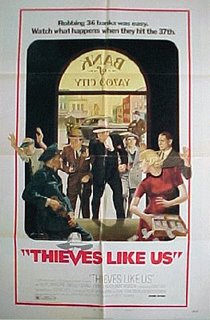 One of the most fascinating and illuminating ongoing projects happening right now in the film blogosphere is Jim Emerson’s Opening Shots series over at his excellent blog Scanners. Jim is taking submissions from readers which describe, in as much detail as the writer cares to go into, memorable, moving, expressive, thematically resonant opening shots-- emphatically not opening sequences, but strictly the very first shot in the movie—and how these shots work to telegraph, expand or otherwise illustrate some of the film’s meaning or intent as it will unfold throughout the running time. As Jim stated when he initiated this project, “Any good movie -- heck, even the occasional bad one -- teaches you how to watch it. And that lesson usually starts with the very first image.”
One of the most fascinating and illuminating ongoing projects happening right now in the film blogosphere is Jim Emerson’s Opening Shots series over at his excellent blog Scanners. Jim is taking submissions from readers which describe, in as much detail as the writer cares to go into, memorable, moving, expressive, thematically resonant opening shots-- emphatically not opening sequences, but strictly the very first shot in the movie—and how these shots work to telegraph, expand or otherwise illustrate some of the film’s meaning or intent as it will unfold throughout the running time. As Jim stated when he initiated this project, “Any good movie -- heck, even the occasional bad one -- teaches you how to watch it. And that lesson usually starts with the very first image.”In further explaining the genesis of the project, Jim went on to say, “Two of my cardinal rules for movie-watching are:
1) The movie is about what happens to you while you watch it. So, pay attention -- to both the movie and your response. If you have reactions to, or questions about, what you're seeing, chances are they'll tell you something about what the movie is doing. Be aware of your questions, emotions, apprehensions, expectations.
2) The opening shot (or opening sequence) is the most important part of the movie... at least until you get to the final shot. (And in good movies, the two are often related.)
The opening shot can tell us a lot about how to interpret what follows. It can even be the whole movie in miniature.”
Jim kicked off the series with a spectacular exegesis of the opening shot of Stanley Kubrick’s Barry Lyndon, complete with screen grabs to remind you (if anyone needed reminding) of just how great, how tactile, how gorgeous Kubrick and cinematographer John Alcott made that film look. I defy you to read this piece and then resist the urge to run right out and rent (or even buy) Barry Lyndon so you can get another look at it. Jim has also contributed excellent readings of the opening shots of Alan Rudolph’s Choose Me, Shane Caruth’s Primer and Richard Linklater’s Slacker, with more from him to come, I suspect—- I hope!
But Jim has had many other wonderful, eye-opening and eye-popping contributions grace his pages since the project kicked off just over a month ago too, including...
Kim Morgan on Kiss Me, Deadly (check out Kim’s blog, Sunset Gun, a brand-new addition to the SLIFR sidebar)
Peet Gelderblom on Altered States
Robert Cumbow on Halloween (read this one now!)
That Little Round-Headed Boy on His Girl Friday
Dave McCoy on Miller’s Crossing (a movie Jim correctly describes as one of the best movies of the ‘90s)
Nadia Aboufariss on Aguirre, The Wrath of God
Mike Leto on Dazed and Confused
Girish Shambu on Flowers of Shanghai (read this one now, and then rent the movie!)
Edward Copeland on The Crying Game
Christopher Long on Stranger Than Paradise
Scott Gowans on Beware of a Holy Whore
Mark Robert on Superman, Lost in Translation and more
Leonard Maltin on Scarecrow
Jonathan Pacheco on 2001: A Space Odyssey
Jeremy Matthews on Cache
Brad Damare on George A. Romero’s Dawn of the Dead
Robert Daniel on Deep Red
Ali Arikan on Withnail and I
John Hartl on Nights of Cabiria (read this one now!)
Robert Humanick on Fight Club (read this one now!)
Richard T. Jameson on Accident and Juggernaut
Barry Toffoli, Mike Leto, Justin Russo and Alex Murillo on Star Wars
Roger Ebert, Drew Holton, Hiram M. and Chris Oliver on The Good, the Bad and the Ugly
and Hiram M. again, this time on Annie Hall.
And for those who still haven’t sent in their essays and comments, Jim has also provided a handy lexicon of film terminology, just so, as he says, we can be sure we’re all speaking the same language when it comes to Opening Shots.

I’ve been a fan of Scanners for quite some time, and I was thrilled when Jim noticed Professor Van Helsing’s Spring Break Quiz some months back and made a fuss over it on his site. Ever since then we’ve communicated via e-mail and through each other’s blogs, and I think I’m probably most excited and proud of my (brief) association with Jim because he seems like a genuinely kind and interested person, and Scanners is a model of what I hope SLIFR can someday become. I really value and enjoy his accessible, humane, non-snarky, thoughtful, intelligent, critical writing, and I especially value the tone he has set with that writing and with Scanners, one of respect for the opinions of others, even those with which he may disagree. Scanners is not a place to get flamed or to do the flaming, and it’s clear his readers value Jim’s blog as a Internet safe haven from the monosyllabic tirades and abuse that comprises so many forum “discussion groups.” (Have you had a look at the Fray on Slate lately?) He has cultivated an arena of mutual respect between himself and his readers, even as he occasionally takes it to those in the creative community who deserve the willow-switch treatment, and it’s one of many elements that makes Scanners a consistent, addictive, unpredictable joy to read.
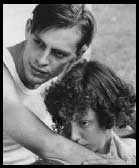 When Jim invited me to participate in his Opening Shots survey, I accepted with enthusiasm and then immediately began to worry. Every example of a great opening shot that was coming to mind ("Touch of Evil," "The Player," "Shadow of a Doubt") had already been pawed over and written about to such a degree that I certainly didn’t think I would have anything more to add to the discussion that hadn’t already been said, and far more eloquently than I would be able to say it. And as I continued to drag my feet, I saw some of the off-the-chart top choices I had come up with ("Dazed and Confused," "Kiss Me Deadly") get snapped up and written about, again, quite eloquently, by others. So, after digging through my DVD and laserdisc collection, I finally came up with what I think are some great ones, and as usual I haven’t the discipline to hold myself to just one. I sent them all to Jim to use at his discretion, but I promised I wouldn’t publish them on this site until after he’s used them. (The ones he doesn’t use, well, I’ll publish them too, just because I feel sorry for them.)
When Jim invited me to participate in his Opening Shots survey, I accepted with enthusiasm and then immediately began to worry. Every example of a great opening shot that was coming to mind ("Touch of Evil," "The Player," "Shadow of a Doubt") had already been pawed over and written about to such a degree that I certainly didn’t think I would have anything more to add to the discussion that hadn’t already been said, and far more eloquently than I would be able to say it. And as I continued to drag my feet, I saw some of the off-the-chart top choices I had come up with ("Dazed and Confused," "Kiss Me Deadly") get snapped up and written about, again, quite eloquently, by others. So, after digging through my DVD and laserdisc collection, I finally came up with what I think are some great ones, and as usual I haven’t the discipline to hold myself to just one. I sent them all to Jim to use at his discretion, but I promised I wouldn’t publish them on this site until after he’s used them. (The ones he doesn’t use, well, I’ll publish them too, just because I feel sorry for them.) On July 15 Jim posted my first submission, a look at the opening shot of Thieves Like Us. Unfortunately, the movie is not on domestic region 1 DVD, which sent Jim scrambling to find an overseas version. His acumen at digging up these morsels is not to be sneezed at—sure enough, the movie is available on a German DVD, which Jim quickly procured and used to obtain the screen shots which he used to illustrate my essay, and which I have borrowed from his site to do the same here. Here then is my contribution to Jim Emerson’s Opening Shot project as it appeared on Scanners.
*************************************************************************************
Thieves Like Us (Robert Altman, 1974; photographed by Jean Boffety)
Robert Altman has had more than one rich, visually stunning opening shot in his long career. From the Panavision image of helicopters racking into focus to kick off M*A*S*H, to Rene Auberjoinois’ mysterious lecturer announcing a series of avian themes and questions while surrounded by bird skeletons and other classroom paraphernalia at the beginning of Brewster McCloud; from Elliot Gould’s Philip Marlowe stretched out on a bed, counteracting the proactive image of Raymond Chandler’s private eye to the strains of “Hooray for Hollywood” [and "The Long Goodbye" -- JE] to open The Long Goodbye, to the K-Tel-esque record commercial that serves as the opening credits of Nashville, to the raising of the flag by bugle call leading into the staged massacre that opens Buffalo Bill and the Indians, or Sitting Bull’s History Lesson (proclaimed on-screen with satiric bombast as “Robert Altman’s Absolutely Unique and Heroic Enterprise of Inimitable Lustre!”), Altman knows how to kick off a movie.
One of his most beautiful opening shots, however, occurs at the beginning of Thieves Like Us, a shot that artfully prepares us for the somber mood, the deliberate, unhurried pace of the film as a whole, and its naturalistic attitude toward the story it intends to tell, that of the doomed relationship between a young escaped convict and the naive young woman with whom he falls in love.
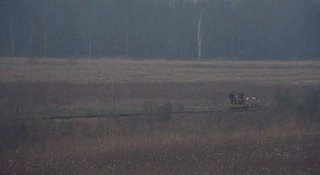
As is often the case in an Altman film, we hear some ambient or film-related sound layered in underneath the studio logo — this time there are crows heard cawing underneath the United Artists logo. The shot fades up on an open stretch of field, backed by a thicket of forest and bisected horizontally by a length of railroad track. A handcar enters the frame and travels from right to left silently. Two men sit at the head of the car, dressed in matching brown jackets. On the floor of the car sit at least ten men, dressed in prison stripes. As the car gets closer we can see the men in brown are carrying rifles.

The camera begins a slow pan right to left in order to follow the car. A thicket of trees passes in between the camera and the car as it purposefully moves along the track. The handcar crosses a road where a pickup truck, ‘20s vintage, sits near the railroad crossing, no one inside. The car continues right to left and begins receding away from the camera, which continues along right to left and onto an expanse of green field. The car disappears in the distance as the camera continues discovering this new landscape -- there are more trees, the ground is broken up by patches of rough soil and hilly contours and patches of dry brush. Suddenly we see a lake, and on that lake a boat occupied by two men. The camera continues to pan, following the boat’s progress as the men row toward shore and make a sharp left toward the nearest bank.
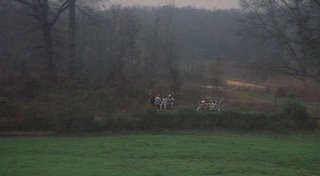

The camera, for the first time since the shot began, stops its pan in order to observe the men as they silently approach. There is a water tower and some small buildings visible through the trees off to the left. The camera begins to slowly move again, tracking ever so slightly the movement of the boat. We can now hear the conversation taking place between the two, but it is unclear exactly what is being discussed. It turns out, unsurprisingly, that the men are talking about fishing. (“The best time to go fishing is in the rain,” says the larger of the two men.) As they make shore, the camera continues its familiar right-to-left pattern. The water tower still looms in the background, unassumingly part of the landscape—the men are clearly on or near farm property. There’s a horse visible in the background, off to the left, and we slowly realize that there are prisoners working beside the horse too, and that the man on the horse is the work detail guard. The men pay no attention to the prisoners though—they get out of the boat and the larger man says, regarding their haul of fish, “Not a bad day’s work.” The smaller man agrees. The larger man then tosses the fish on the ground near the shore and says, “You fellas take care of the boat.”


Clearly, these fishermen are not concerned with cleaning and eating their catch. As the two move quickly up the hill right to left, the larger man continues: “I know they’re not gonna be here.” The smaller man replies: “They might.” By now they’ve moved up to the crest of the hill, alongside a road, and the larger man, seeing no one there waiting, says, “I told ya! They’re not here.” Smaller man: “No, look. See? There.” Larger man: “Where?” Smaller man: “There.” The men settle on a top of the crest looking down over the far edge of the very same open stretch of field that began the shot. We now realize that the opening shot has been one big circular motion—the field this time divided by opposing angles of road, rather than railroad track, down which travels a car that the men are very intent upon observing as it moves closer. Larger man: “Who’s drivin?” Smaller man: “Who was that guy that sells marijuana? The prison guy.” Larger man: “Jazzbo?”
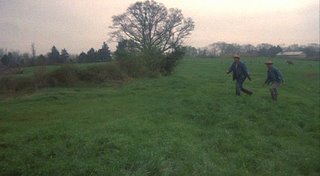
The opening shot ends with a cut to a closer shot of the car as it barrels down the road toward the place where the two men are squatting. The men have revealed themselves, within the confines of this gorgeously choreographed opener, as very calm, cool prison escapees. And this information has been directed to us in a way that provides pieces of this minor puzzle of identification all through the duration of the shot, so that by the end we know the basics of these characters and their situation, and does so poetically, and antithetically to the approach that most any other director, who might feel compelled to show us the suspenseful escape or some violent occurrence along the way, might choose to take.

*************************************************************************************
Be sure to stay tuned to Scanners for more Opening Shots— there's no end to the series in sight, and that’s only good news for anyone who loves to read good writing about great movies—and with pictures too!
Thanks, Jim, for allowing me to take part in Opening Shots, for your superb blog Scanners, for the use of the images, and for fast becoming a friend in this wide and vast blogosphere. If you’re ever in Los Angeles, it’s Dodger Stadium and a beer on me!

Thanks for the enthusiastic support of all these opening shots contributions. I've a few others still ruminating upstairs, and one more right now that Jim has will hopefully post in the near future. Your own deconstruction of these scenes has helped me in thinking about what a film/scene does and how it relates to the rest of the film, even in cases when I haven't seen the movie in question! That kind of passion about art is wonderful, when you can spread the joys and insights from a work to the uninitiated. I definitely enjoy this blog, and I'll be hanging around for the future.
ReplyDeleteBeautiful, just beautiful.
ReplyDeleteThat is such a great opening shot,
and it really does set a tone, doesn't it?
I just got done studying "M*A*S*H" again, and its opening shot is so simple, the title graphic rack-focusing in, with that Panavision anamorphic distortion, just barely time to read it, the guitar string notes, then the helicopters flying, with those muted color tones.
I can't believe Altman is gone.
He gave us so much, and I can't
believe the last time I saw him,
is the last time I will see him.
I wrote about it.
http://samlongoria.blogspot.com